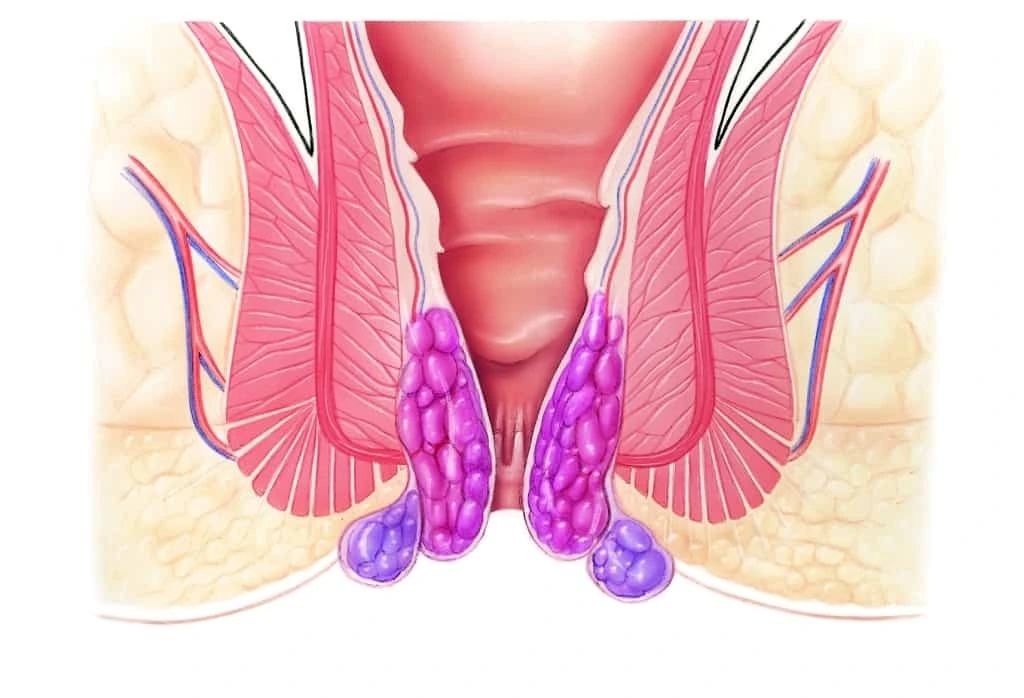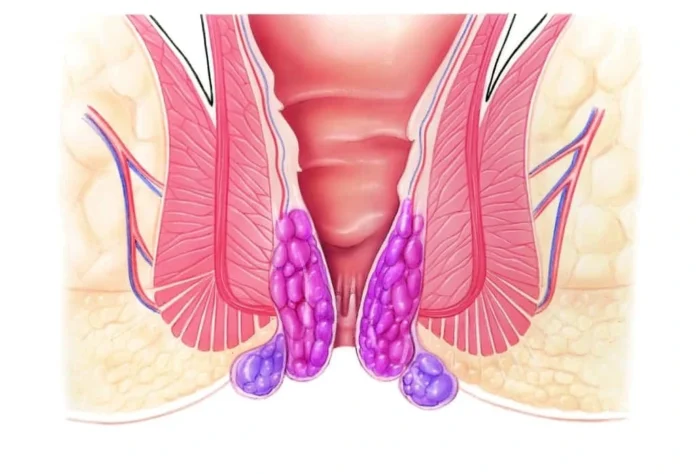Hemorrhoidal disease, commonly known as piles, is a prevalent condition characterized by the swelling and inflammation of veins in the rectal and anal regions.Piles often called hemorrhoidal disease, swell and irritate veins in your backside and near your rear. Loads of folks deal with this, getting hit with the aches, stings, and all that comes with it. To tackle it right and stop it before it starts, you gotta get the lowdown on why it happens, the signs you’re dealing, what kind it is, and ways to fix it up.

So, you’ve got hemorrhoids, huh? That’s when the blood vessels by your backside get all puffy—kinda like the varicose veins some folks have in their legs. These puffed-up vessels, which people call hemorrhoids or piles, can pop up deep in the rectum or stick out around the back door. , these guys are just part of the body doing its thing, but man when they get swollen, they can make you miserable with bleeding, itching, and some serious discomfort.
Kinds of Hemorrhoids
Let’s break it down into the two big groups:
- Inner Hemorrhoids: Hidden out of sight in the rectum, these are the stealthy kind. They’re not something you can feel or see, and they’ll sneak up on you with bleeding when you’re doing your business, but without causing you any hurt.
- External Hemorrhoids: You’ll find these under the skin of your bottom, and oh boy, they can make you pretty uncomfortable. When they flare up, you might notice pain, swelling, or even a furious itch.
Usual Reasons
Okay so you might be wondering why hemorrhoids pop up. Here are a few things that lead to them:
- When You Push During Bathroom Breaks: This just puts more pressure on the blood vessels down there causing them to puff up.
- If you’re always bunged up or racing to the loo, that’s going to make your rectal veins unhappy and uncomfortable.
- Hanging out on the Throne Too Long: Spending ages on the toilet isn’t gonna do you any favors and might make those bad boys sting a bit more.
- When You’re Expecting a Baby: All that extra weight pushing down in your lower belly during pregnancy is another way you might get acquainted with hemorrhoids.
- Low-Fiber Diet: Not eating enough fiber might make your stools tough, and you’ve gotta push harder when you go to the bathroom.
Stuff to Keep an Eye On
What you feel with hemorrhoids changes based on the kind:
- Internal Hemorrhoids: , they don’t hurt, but you’ll see bright red blood when you go. Sometimes, they pop out and bother you.
- External Hemorrhoids: These guys can make you itchy and swell up near your behind. If they get a blood clot, it’s gonna hurt a lot and get pretty swollen.
Ways to Stop ‘Em Before They Start
Switching up how you live can be a big help in keeping hemorrhoids from bugging you:
- Eat More Fiber: Pack your diet with fruits, veggies, and whole grains to make stools softer and scale back on straining.
- Drink Lots of Water: Getting the right amount of water is a big help in digestion and keeps constipation away.
- Work Out Often: Being active helps keep your bowel movements regular and eases the pressure on your bum veins.
- Don’t Sit Too Much: Make sure to get up and move around instead of sitting a whole bunch, and don’t hang out on the loo too long.
What Leads to Hemorrhoidal Disease
A mix of things can lead to hemorrhoids popping up:
- Gruntin’ When Ya Go: Trying too hard to go ’cause ya can’t or you’re dealing with tough-to-pass poops, puts a lot on those bum veins, makin’ ’em puff up.
- Regularly Can’t Go or Gotta Go Too Much: Both situations can make you strain a ton and bug your bum area, which starts the whole hemorrhoid party.
- Havin’ a Bun in the Oven: That extra weight from your little passenger and body changes when you’re expectin’ can make those backside veins get chunky and cause piles.
- Packing Extra Pounds: If you’re carrying more weight than you should around your middle, it leans heavy on those below-the-belt veins uppin’ your chances of gettin’ hemorrhoids.
- Prolonged Sitting or Standing: Staying still for too long might mess with blood circulation leading to swollen veins in the rectum.
- Aging: Getting older often means the stuff holding up the veins in your butt gets weaker, and that ups your chances of getting hemorrhoids.
Hemorrhoidal Disease Signs
Hemorrhoidal disease signs differ if the hemorrhoids are inside or outside.
- Internal Hemorrhoids: You’ll find these inside the rectum and they don’t hurt. They show up as:
- Painless Bleeding: If there’s bright red blood on your toilet paper or in the bowl after you go, it’s a sign.
- Prolapse: Sometimes during pushing, a hemorrhoid sticks out the butt but goes back in later.
- External Hemorrhoids: These guys hang out under the skin near your back door and they can cause some issues like:
- Itching or Irritation: When things get swollen and puffy, this happens.
- Sometimes when you’re sitting or doing your business, you might feel some achiness or unease.
- Swelling: This happens right around the exit ramp.
- Bleeding: It’s pretty obvious when stuff’s moving out.
Sometimes a thrombosed hemorrhoid happens when a blood clot develops in an external hemorrhoid. This condition comes with a lot of pain, a swollen area, and a firm bump close to your butt.
Kinds and Phases of Hemorrhoids
Docs sort out hemorrhoids by where they’re at and how bad they are:
- Internal Hemorrhoids: These pop up inside the rectum and we sort them out into four levels:
- Grade 1: They just chill there with no prolapse; the hemorrhoid stays put inside.
- Grade 2: Pops out when you strain but goes back in on its own.
- Grade 3: This one’s a bit of a pain popping out and needing a hand to get pushed back in.
- Grade 4: It’s out all the time, won’t go back in, and you might need to talk to a surgeon about it.
- External Hemorrhoids: These guys hang out under the skin near your back door and they can make you squirm if they get all clotted up.
Giving Hemorrhoidal Disease the Boot
Options to treat hinge on how bad and what kind of hemorrhoids we’re talking about.
- Home Cures:
- Switching Up What You Eat: Adding eats like fruits, veggies, and grains full of fiber can help make poop soft and lessen the need to push hard.
- Staying Watered: It’s good to drink a bunch of water to keep away from being backed up.
- Chilling in Warm Water: Taking a seat in water that’s nice and warm for a bit, like 10-15 minutes, can take the edge off the soreness.
- Stuff You Can Buy Without a Prescription: You got stuff like creams or salves with something called hydrocortisone, and it’s ace for calming down redness and that itch.
- Doctor’s Fixes:
- Putting on a Rubber Band: Docs wrap a tiny rubber band ’round the bottom of the lump to stop the blood flowing to it so it shrinks and drops off.
- They shrink hemorrhoids in this thing called sclerotherapy by shooting chemicals into them.
- Coagulation Therapy: They use lasers or infrared stuff to make the hemorrhoid tough and small.
- Surgical Interventions:
- Hemorrhoidectomy: When things get real bad, they just cut out the big hemorrhoids.
- Stapled Hemorrhoidopexy: This is like a stapling gig where they stop the blood from going to the hemorrhoid so it gets tiny.
talk to a medical pro to figure out the best way to tackle your specific symptoms and how bad your condition is.
Dodging Hemorrhoidal Disease
Here’s what you can do to steer clear:
- Eat Lots of Fiber: This makes sure your bowel movements are easy-peasy.
- Drink Plenty of Water: Keeping hydrated is key to avoiding the hard stool.
- **Exercise **: Gets your bowels moving the way they should.
- Don’t Sit or Stand Too Long: Takes the heat off your bottom veins.
Choices for Getting Better
How you deal with hemorrhoids depends on how much they bug you:
- Stuff You Can Do at Home: Taking warm sitz baths, using creams from the store, and applying cold packs can take the edge off if it’s not too serious.
- Medical Procedures: If your hemorrhoids keep bothering you or they’re real bad, docs might suggest zapping them with treatments like tying them off with rubber bands injecting them to shrink them, or using infrared light to burn them off.
- Surgical Intervention: On the off chance that simpler treatments just ain’t cutting it, going under the knife with stuff like slicing them out or using staples to put things back in place could be the next step.
When You Gotta Get Help
Look, piles are pretty normal, and they tend to skedaddle on their own, but you gotta holler at a doc when stuff gets serious, like:
- Excessive Bleeding: I’m talking if you start feeling woozy or like you might keel over.
- Severe Pain: We mean agony that’s wrecking your day and you can’t handle it.
- Persistent Symptoms: When no amount of chilling at home or those DIY fixes are making you feel any better.
If you need in-depth info on hemorrhoids, what brings them on, and how to deal with them, peep this killer guide:
citeturn0search11
Get the lowdown on managing hemorrhoids and you could score some solid comfort, not to mention a better day-to-day vibe.
Wrapping It Up
Mouth sores might not be a big deal, but jeez, they can be a pain. Figuring out why they pop up and dodging them with some smart moves can cut down on how often they crash your party. Got ulcers that just won’t quit or driving you nuts? You gotta hit up a doc to make sure nothing scary’s going on and to snag the right fix.
Wanna dive into the nitty-gritty? Bounce over to the Mouth Ulcer article on Wikipedia.

